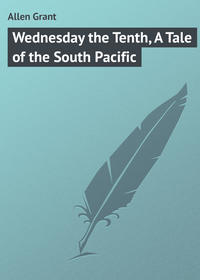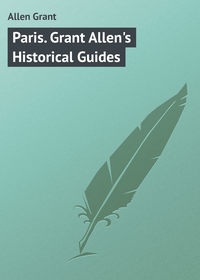 полная версия
полная версияCities of Belgium. Grant Allen's Historical Guides

Grant Allen
Cities of Belgium / Grant Allen's Historical Guides
PREFACE TO THE SECOND EDITION
RECENT alterations, especially in the Brussels Gallery, make a new edition of this book imperative, and, as I had been with my father during its inception, I have undertaken such revision as is necessary. In the main, however, my work has been merely mechanical, and the guide remains substantially identical in detail with that originally published in 1897.
Since that date it has been remarked in more than one quarter that many interesting towns and objects have been omitted. I can only reply that it would be impossible to deal exhaustively with a country so rich in historical and artistic interest as Belgium in a single volume of this size, and that my father only professed to point out such sights in the chief towns as seemed to him most worthy of interest.
To alter even slightly the work of an author (especially when, as in this case, that author is powerless to object) is a task to be approached with the utmost diffidence, and I can only trust that those who use this book will impute all blame for any errors or omissions wholly to me, rather than to one who is beyond the reach of criticism.
JERRARD GRANT ALLEN.July, 1902.
INTRODUCTION
THE object and plan of these Historical Handbooks is somewhat different from that of any other guides at present before the public. They do not compete or clash with such existing works; they are rather intended to supplement than to supplant them. My purpose is not to direct the stranger through the streets and squares of an unknown town towards the buildings or sights which he may desire to visit; still less is it my design to give him practical information about hotels, cab fares, omnibuses, tramways, and other every-day material conveniences. For such details, the traveller must still have recourse to the trusty pages of his Baedeker, his Joanne, or his Murray. I desire rather to supply the tourist who wishes to use his travel as a means of culture with such historical and antiquarian information as will enable him to understand, and therefore to enjoy, the architecture, sculpture, painting, and minor arts of the towns he visits. In one word, it is my object to give the reader in a very compendious form the result of all those inquiries which have naturally suggested themselves to my own mind during thirty-five years of foreign travel, the solution of which has cost myself a good deal of research, thought, and labour, beyond the facts which I could find in the ordinary handbooks.
For several years past I have devoted myself to collecting and arranging material for a set of books to embody the idea I had thus entertained. I earnestly hope they may meet a want on the part of tourists, especially Americans, who, so far as my experience goes, usually come to Europe with an honest and reverent desire to learn from the Old World whatever of value it has to teach them, and who are prepared to take an amount of pains in turning their trip to good account which is both rare and praiseworthy. For such readers I shall call attention at times to other sources of information.
These guide-books will deal more particularly with the Great Towns where objects of art and antiquity are numerous. In every one of them, the general plan pursued will be somewhat as follows. First will come the inquiry why a town ever gathered together at all at that particular spot – what induced the aggregation of human beings rather there than elsewhere. Next, we shall consider why that town grew to social or political importance and what were the stages by which it assumed its present shape. Thirdly, we shall ask why it gave rise to that higher form of handicraft which we know as Art, and towards what particular arts it especially gravitated. After that, we shall take in detail the various strata of its growth or development, examining the buildings and works of art which they contain in historical order, and, as far as possible, tracing the causes which led to their evolution. In particular, we shall lay stress upon the origin and meaning of each structure as an organic whole, and upon the allusions or symbols which its fabric embodies.
A single instance will show the method upon which I intend to proceed better than any amount of general description. A church, as a rule, is built over the body or relics of a particular saint, in whose special honour it was originally erected. That saint was usually one of great local importance at the moment of its erection, or was peculiarly implored against plague, foreign enemies, or some other pressing and dreaded misfortune. In dealing with such a church, then, I endeavour to show what were the circumstances which led to its erection, and what memorials of these circumstances it still retains. In other cases it may derive its origin from some special monastic body – Benedictine, Dominican, Franciscan – and may therefore be full of the peculiar symbolism and historical allusion of the order who founded it. Wherever I have to deal with such a church, I try as far as possible to exhibit the effect which its origin had upon its architecture and decoration; to trace the image of the patron saint in sculpture or stained glass throughout the fabric; and to set forth the connection of the whole design with time and place, with order and purpose. In short, instead of looking upon monuments of the sort mainly as the product of this or that architect, I look upon them rather as material embodiments of the spirit of the age – crystallizations, as it were, in stone and bronze, in form and colour, of great popular enthusiasms.
By thus concentrating attention on what is essential and important in a town, I hope to give in a comparatively short space, though with inevitable conciseness, a fuller account than is usually given of the chief architectural and monumental works of the principal art-cities. In dealing with Paris, for example, I shall have little to say about such modern constructions as the Champs Élysées or the Eiffel Tower; still less, of course, about the Morgue, the Catacombs, the waxworks of the Musée Grévin, and the celebrated Excursion in the Paris Sewers. The space thus saved from vulgar wonders I shall hope to devote to fuller explanation of Notre-Dame and the Sainte Chapelle, of the mediæval carvings or tapestries of Cluny, and of the pictures or sculptures in the galleries of the Louvre. Similarly in Florence, whatever I save from description of the Cascine and even of the beautiful Viale dei Colli (where explanation is needless and word-painting superfluous), I shall give up to the Bargello, the Uffizi, and the Pitti Palace. The passing life of the moment does not enter into my plan; I regard each town I endeavour to illustrate mainly as a museum of its own history.
For this reason, too, I shall devote most attention in every case to what is locally illustrative, and less to what is merely adventitious and foreign. In Paris, for instance, I shall have more to say about truly Parisian art and history, as embodied in St. Denis, the Île de la Cité, and the shrine of Ste. Geneviève, than about the Egyptian and Assyrian collections of the Louvre. In Florence, again, I shall deal rather with the Etruscan remains, with Giotto and Fra Angelico, with the Duomo and the Campanile, than with the admirable Memlincks and Rubenses of the Uffizi and the Pitti, or with the beautiful Van der Goes of the Hospital of Santa Maria. In Bruges and Brussels, once more, I shall be especially Flemish; in the Rhine towns, Rhenish; in Venice, Venetian. I shall assign a due amount of space, indeed, to the foreign collections, but I shall call attention chiefly to those monuments or objects which are of entirely local and typical value.
As regards the character of the information given, it will be mainly historical, antiquarian, and, above all, explanatory. I am not a connoisseur – an adept in the difficult modern science of distinguishing the handicraft of various masters, in painting or sculpture, by minute signs and delicate inferential processes. In such matters, I shall be well content to follow the lead of the most authoritative experts. Nor am I an art-critic – a student versed in the technique of the studios and the dialect of the modelling-room. In such matters, again, I shall attempt little more than to accept the general opinion of the most discriminative judges. What I aim at rather is to expound the history and meaning of each work – to put the intelligent reader in such a position that he may judge for himself of the æsthetic beauty and success of the object before him. To recognise the fact that this is a Perseus and Andromeda, that a St. Barbara enthroned, the other an obscure episode in the legend of St. Philip, is not art-criticism, but it is often an almost indispensable prelude to the formation of a right and sound judgment. We must know what the artist was trying to represent before we can feel sure what measure of success he has attained in his representation.
For the general study of Christian art, alike in architecture, sculpture, and painting, no treatises are more useful for the tourist to carry with him for constant reference than Mrs. Jameson’s Sacred and Legendary Art, and Legends of the Madonna (London, Longmans). For works of Italian art, both in Italy and elsewhere, Kugler’s Italian Schools of Painting is an invaluable vade-mecum. These books should be carried about by everybody everywhere. Other works of special and local importance will occasionally be noticed under each particular city, church, or museum.
I cannot venture to hope that handbooks containing such a mass of facts as these will be wholly free from errors and misstatements, above all in early editions. I can only beg those who may detect any such to point them out, without unnecessary harshness, to the author, care of the publisher, and if possible to assign reasons for any dissentient opinion.
GRANT ALLENHOW TO USE THESE GUIDEBOOKS
THE portions of this book intended to be read at leisure at home, before proceeding to explore each town or monument, are enclosed in brackets [thus]. The portion relating to each principal object should be quietly read and digested before a visit, and referred to again afterwards. The portion to be read on the spot is made as brief as possible, and is printed in large legible type, so as to be easily read in the dim light of churches, chapels, and galleries. The key-note words are printed in bold type, to catch the eye. Where objects are numbered, the numbers used are always those of the latest official catalogues.
Baedeker’s Guides are so printed that each principal portion can be detached entire from the volume. The traveller who uses Baedeker is advised to carry in his pocket one such portion, referring to the place he is then visiting, together with the plan of the town, while carrying this book in his hand. These Guides do not profess to supply practical information.
Individual works of merit are distinguished by an asterisk (*); those of very exceptional interest and merit have two asterisks. Nothing is noticed in this book which does not seem to the writer worthy of attention.
See little at a time, and see it thoroughly. Never attempt to “do” any place or any monument. By following strictly the order in which objects are noticed in this book, you will gain a conception of the historical evolution of the town which you cannot obtain if you go about looking at churches and palaces hap-hazard. The order is arranged, not quite chronologically, but on a definite plan, which greatly facilitates comprehension of the subject.
ORIGINS OF THE BELGIAN TOWNS
THE somewhat heterogeneous country which we now call Belgium formed part of Gaul under the Roman Empire. But though rich and commercial even then, it seems to have been relatively little Romanised; and in the beginning of the 5th century it was overrun by the Salic Franks, on their way towards Laon, Soissons, and Paris. When civilization began to creep northward again in the 9th century through the districts barbarised by the Teutonic invasion, it was the Frankish Charlemagne (Karl the Great) who introduced Roman arts afresh into the Upper and Lower Rhinelands. The Rhine from Basle to Cologne was naturally the region most influenced by this new Roman revival; but as Charlemagne had his chief seat at Aix-la-Chapelle (Aachen), near the modern Belgian frontier, the western Frankish provinces were also included in the sphere of his improvements. When the kingdom of the Franks began to divide more or less definitely into the Empire and France, the Flemish region formed nominally part of the Neustrian and, later, of the French dominions. From a very early date, however, it was practically almost independent, and it became so even in name during its later stages. But Brabant (with Brussels) remained a portion of the Empire.
The Rhine constituted the great central waterway of mediæval Europe; the Flemish towns were its ports and its manufacturing centres. They filled in the 13th and 14th centuries much the same place that Liverpool, Glasgow, Manchester, and Birmingham fill in the 20th. Many causes contributed to this result. Flanders, half independent under its own Counts, occupied a middle position, geographically and politically, between France and the Empire; it was comparatively free from the disastrous wars which desolated both these countries, and in particular (see under Ghent) it largely escaped the long smouldering quarrel between French and English which so long retarded the development of the former. Its commercial towns, again, were not exposed on the open sea to the attacks of pirates or hostile fleets, but were safely ensconced in inland flats, reached by rivers or canals, almost inaccessible to maritime enemies. Similar conditions elsewhere early ensured peace and prosperity for Venice. The canal system of Holland and Belgium began to be developed as early as the 12th century (at first for drainage), and was one leading cause of the commercial importance of the Flemish cities in the 14th. In so flat a country, locks are all but unnecessary. The two towns which earliest rose to greatness in the Belgian area were thus Bruges and Ghent; they possessed in the highest degree the combined advantages of easy access to the sea and comparative inland security. Bruges, in particular, was one of the chief stations of the Hanseatic League, which formed an essentially commercial alliance for the mutual protection of the northern trading centres. By the 14th century Bruges had thus become in the north what Venice was in the south, the capital of commerce. Trading companies from all the surrounding countries had their “factories” in the town, and every European king or prince of importance kept a resident minister accredited to the merchant Republic.
Some comprehension of the mercantile condition of Europe in general during the Middle Ages is necessary in order to understand the early importance and wealth of the Flemish cities. Southern Europe, and in particular Italy, was then still the seat of all higher civilization, more especially of the trade in manufactured articles and objects of luxury. Florence, Venice, and Genoa ranked as the polished and learned cities of the world. Further east, again, Constantinople still remained in the hands of the Greek emperors, or, during the Crusades, of their Latin rivals. A brisk trade existed viâ the Mediterranean between Europe and India or the nearer East. This double stream of traffic ran along two main routes – one, by the Rhine, from Lombardy and Rome; the other, by sea, from Venice, Genoa, Florence, Constantinople, the Levant, and India. On the other hand, France was still but a half civilized country, with few manufactures and little external trade; while England was an exporter of raw produce, chiefly wool, like Australia in our own time. The Hanseatic merchants of Cologne held the trade of London; those of Wisby and Lübeck governed that of the Baltic; Bruges, as head of the Hansa, was in close connection with all of these, as well as with Hull, York, Novgorod, and Bergen. The position of the Flemish towns in the 14th century was thus not wholly unlike that of New York, Philadelphia, and Boston at the present day; they stood as intermediaries between the older civilized countries, like Italy or the Greek empire, and the newer producers of raw material, like England, North Germany, and the Baltic towns.
The local manufactures of Flanders consisted chiefly of woollen goods and linens; the imports included Italian luxuries, Spanish figs and raisins, Egyptian dates, Oriental silks, English wool, cattle, and metals, Rhenish wines, and Baltic furs, skins, and walrus tusks.
In the early 16th century, when navigation had assumed new conditions, and trade was largely diverted to the Atlantic, Antwerp, the port of the Schelde, superseded the towns on the inland network. As Venice sank, Antwerp rose.
The art that grew up in the Flemish cities during their epoch of continuous commercial development bears on its very face the visible impress of its mercantile origin. France is essentially a monarchical country, and it is centralized in Paris; everything in old French art is therefore regal and lordly. The Italian towns were oligarchies of nobles; so the principal buildings of Florence and Venice are the castles or palaces of the princely families, while their pictures represent the type of art that belongs in its nature to a cultivated aristocracy. But in Flanders, everything is in essence commercial. The architecture consists mainly, not of private palaces, but of guilds, town halls, exchanges, belfries: the pictures are the portraits of solid and successful merchants, or the devotional works which a merchant donor presented to the patron saint of his town or business. They are almost overloaded with details of fur, brocade, jewellery, lace, gold, silver, polished brass, glasswork, Oriental carpets, and richly carved furniture. In order to understand Flemish art, therefore, it is necessary to bear in mind at every step that it is the art of a purely commercial people.
Another point which differentiates Flemish painting from the painting of Italy during the same period is the complete absence of any opportunity for the display of frescoes. In the Italian churches, where the walls serve largely for support, and the full southern light makes the size of the windows of less importance, great surfaces were left bare in the nave and aisles, or in the lower part of the choir, crying aloud for decoration at the hands of the fresco-painter. But in the northern Gothic, which aimed above all things at height and the soaring effect, and which almost annihilated the wall, by making its churches consist of rows of vast windows with intervening piers or buttresses, the opportunity for mural decoration occurred but seldom. The climate also destroyed frescoes. Hence the works of pictorial art in Flemish buildings are almost confined to altar-pieces and votive tablets. Again, the great school of painting in early Italy (from Giotto to Perugino) was a school of fresco-painters; but in Flanders no high type of art arose till the discovery of oil-painting. Pictures were usually imported from the Rhine towns. Hence, pictorial art in the Low Countries seems to spring almost full-fledged, instead of being traceable through gradual stages of evolution as in Italy. Most of the best early paintings are small and highly finished; it was only at a comparatively late date, when Antwerp became the leading town, that Italian influence began to produce the larger and coarser canvases of Rubens and his followers.
Very early Flemish art greatly resembles the art of the School of Cologne. Only with Hubert and Jan van Eyck (about 1360-1440) does the distinctively Flemish taste begin to show itself – the taste for delicate and minute workmanship, linked with a peculiar realistic idealism, more dainty than German work, more literal than Italian. It is an art that bases itself upon truth of imitation and perfection of finish: its chief æsthetic beauty is its jewel-like colour and its wealth of decorative adjuncts. The subsequent development of Flemish painting – the painting that pleased a clique of opulent commercial patrons – we shall trace in detail in the various cities.
Whoever wishes to gain a deeper insight into Flemish painting should take in his portmanteau Sir Martin Conway’s “Early Flemish Artists,” a brilliant and masterly work of the first importance, to which this Guide is deeply indebted.
The political history of the country during this flourishing period of the Middle Ages has also stamped itself, though somewhat less deeply, on the character of the towns and of the art evolved in them. The Counts of Flanders, originally mere lords of Bruges and its district, held their dominions of the Kings of France. Their territory included, not only Arras (at first the capital, now included in France) with Bruges, Ghent, Courtrai, Tournay, and Ypres, but also the towns and districts of Valenciennes, Lille, and St. Omer, which are now French. From the time of Baldwin VIII. (1191), however, Arras became a part of France, and Ghent was erected into the capital of Flanders. In the beginning of the 13th century, two women sovereigns ruled in succession; under them, and during the absence of the elective Counts on crusades, the towns rose to be practically burgher republics. Bruges, Ypres, Ghent, and Lille were said to possess each 40,000 looms; and though this is certainly a mediæval exaggeration, yet the Flemish cities at this epoch were at any rate the chief manufacturing and trading centres of northern Europe, while London was still a mere local emporium.
In the 14th century, the cities acquired still greater freedom. The citizens had always claimed the right to elect their Count; and the people of Ghent now made treaties without him on their own account with Edward III. of England. To this age belongs the heroic period of the Van Arteveldes at Ghent, when the burghers became the real rulers of Flanders, as will be more fully described hereafter. In 1384, however, Count Louis III. died, leaving an only daughter, who was married to Philip the Bold of Burgundy; and the wealthy Flemish towns thus passed under the sway of the powerful princes of Dijon. Brabant fell later by inheritance to Philip the Good. It was under the Burgundian dynasty, who often held their court at Ghent, that the arts of the Netherlands attained their first great development. Philip the Good (1419-1467) employed Jan van Eyck as his court painter; and during his reign or just after it the chief works of Flemish art were produced in Bruges, Ghent, Brussels, and Tournai.
Charles the Bold, the last Duke of Burgundy, left one daughter, Mary, who was married to Maximilian, afterwards Emperor. From that date forward the history of the Flemish towns is practically merged in that of the dynasty of Charles V., and finally becomes the story of an unwilling and ever justly rebellious Spanish province. The subsequent vicissitudes of Belgium as an Austrian appanage, a part of Holland, and an independent kingdom, belong to the domain of European history. For the visitor, it is the period of the Burgundian supremacy that really counts in the cities of Belgium.
Yet the one great point for the tourist to bear in mind is really this – that the art of the Flemish towns is essentially the art of a group of burgher communities. It is frankly commercial, neither royal nor aristocratic. In its beginnings it develops a strictly municipal architecture, with a school of painters who aimed at portraiture and sacred panel pictures. After the Reformation had destroyed sacred art in Holland, painting in that part of the Netherlands confined itself to portraits and to somewhat vulgar popular scenes: while in Belgium it was Italianised, or rather Titianised and Veronesed, by Rubens and his followers. But in its best days it was national, local, and sacred or personal.











